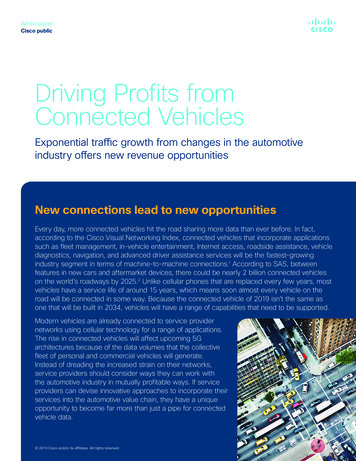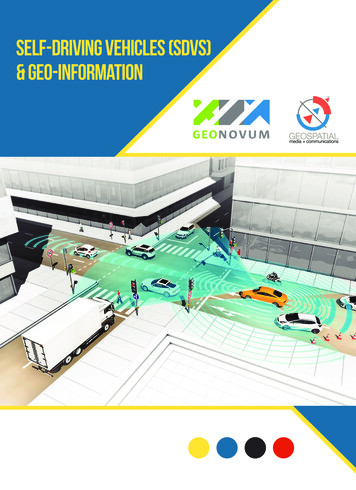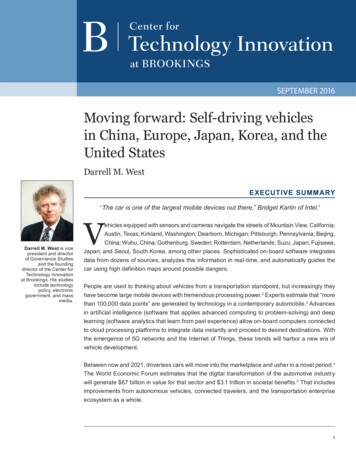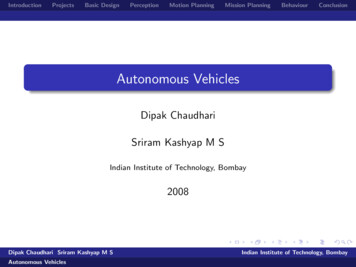
Transcription
White paperCisco publicDriving Profits fromConnected VehiclesExponential traffic growth from changes in the automotiveindustry offers new revenue opportunitiesNew connections lead to new opportunitiesEvery day, more connected vehicles hit the road sharing more data than ever before. In fact,according to the Cisco Visual Networking Index, connected vehicles that incorporate applicationssuch as fleet management, in-vehicle entertainment, Internet access, roadside assistance, vehiclediagnostics, navigation, and advanced driver assistance services will be the fastest-growingindustry segment in terms of machine-to-machine connections.1 According to SAS, betweenfeatures in new cars and aftermarket devices, there could be nearly 2 billion connected vehicleson the world’s roadways by 2025.2 Unlike cellular phones that are replaced every few years, mostvehicles have a service life of around 15 years, which means soon almost every vehicle on theroad will be connected in some way. Because the connected vehicle of 2019 isn’t the same asone that will be built in 2034, vehicles will have a range of capabilities that need to be supported.Modern vehicles are already connected to service providernetworks using cellular technology for a range of applications.The rise in connected vehicles will affect upcoming 5Garchitectures because of the data volumes that the collectivefleet of personal and commercial vehicles will generate.Instead of dreading the increased strain on their networks,service providers should consider ways they can work withthe automotive industry in mutually profitable ways. If serviceproviders can devise innovative approaches to incorporate theirservices into the automotive value chain, they have a uniqueopportunity to become far more than just a pipe for connectedvehicle data. 2019 Cisco and/or its affiliates. All rights reserved.
White paperCisco publicContentsMore vehicles, more sensors,more dataService providers facechallengesTelemetry opportunitiesInfotainment opportunitiesPartnering for successLearn moreMore vehicles, more sensors, more dataConnected vehicles have network access so the vehicle can shareinformation from tire pressure and mechanical systems to navigation,geolocation, and cameras.3 The data about the mechanical state,performance of the vehicle and the driver’s preferences can be used to helpmake driving safer and more enjoyable.Although future production vehicles will generate increasing amounts of data,much of the data generated from an array of sensors and electronic controlunits within the vehicle will be recorded and processed locally. Most of theinformation will be discarded; only valuable data will be transmitted backtoward the vehicle manufacturer.Even though much of the data may not leave the vehicle, it’s clear that datavolumes from vehicles will rapidly outstrip that of smartphones. Cumulativedata volumes from the connected vehicle fleet will place considerable stresson communications network infrastructures with just one connected vehiclepotentially generating as much data as 5.2 smartphones.4Data and duty cyclesRoads carry a variety of vehicle types, and similarly connected vehiclesaren’t all the same. Vehicles may range from heavy-duty freight haulageto public transit services and motorcycles. The amount of information thevehicle transmits to the vehicle manufacturer and when it takes place variesconsiderably. The data volume differs from manufacturer to manufacturer, thetype and model of the vehicle, and what the vehicle is designed to do. A fleetvehicle may generate two data streams, sending data to both the vehiclemanufacturer and to the fleet operator.In the automotive industry, a day or duty cycle is the usage of that vehiclewithin a 24-hour period. In the United States, the average personal lightvehicle travels just over 11,200 miles per year.5 With an average of 261working days per year, cars go approximately 43 miles per day with anaverage transit time of 53.8 minutes.6 2019 Cisco and/or its affiliates. All rights reserved.
White paperCisco publicHowever, a personally owned car that’s driven twice aday for a commute to work doesn’t have the same dutycycle as a bus that’s on the road 18 hours a day. Theduty cycle for different types of vehicles varies widely.For example, public transport and freight vehicles needto be in operation for a significant portion of a 24-hourperiod.network operators and vehicle manufacturers will haveto find ways to support cost-effective deployments at aglobal scale.By way of comparison, in the United States in 2016almost 11.5 million trucks were registered with agrowth rate of approximately 400,000 new trucks beingregistered each year.7 The fleet accrued over 285,000million vehicle miles traveled.Service providers continue to face intense marginpressure just to provide basic consumer connectivity.Traditional sources of revenues aren’t going tobe enough to offset the costs of building out newinfrastructure for 5G. To remain competitive, serviceproviders must seek out new revenue opportunitiesand partnerships. The automotive industry is an areawhere service providers can offer unique advantages.If service providers can gain a better understanding ofthe connectivity, compute, data storage, distribution,and security needs of the automotive industry, they candevise creative ways to work together.For industries such as freight haulage, telemetry is anincreasingly valuable asset because it helps improvethe operating efficiency of vehicles and the safety ofdrivers.8 Performing data analysis on individual drivingpatterns and behavior, traffic on routes, and weatherconditions can yield actionable insights that can reducetime in transit and avoidable idle times. More directly, a2013 report identified that fuel represents 39 percentof the annual operating costs of the average truckin the United States with an average running cost of 180,000.9 Reducing fuel usage across an entire vehiclefleet by as little as 2-3 percent can have significantfinancial and environmental benefits.Today’s cellular networks are able to support therelatively small duty-cycle data volumes. However, asconnected vehicles become increasingly prevalentand the duty-cycle data volumes increase, the cellular 2019 Cisco and/or its affiliates. All rights reserved.Service providers facechallengesIn the networking industry, you hear about edgecomputing a lot. Edge computing is the architecturalprinciple of moving services to locations that canimprove application performance and reduce transportcosts instead of transporting vast amounts of data to acentralized data center.As a service provider, you’ve probably implementededge computing solutions to improve the quality ofexperience for your customers and to reduce operationalcosts. Because certain user applications benefit from
White paperCisco publicedge computing, service providers are using multiaccess edge compute (MEC) to position data centerfunctions closer to users.For service providers, implementing and operatingan edge infrastructure is part of their business. Thisdistributed architecture offers huge advantages forautomotive companies that are concerned about datatransport costs and redundancy. Often automakerssell vehicles all over the globe, but ship vehicle databack to a few centralized data centers. This approachis expensive in terms of transport costs and hashigh-availability implications. With a more distributedarchitecture, any service disruption is localized toa smaller set of vehicles within an area, rather thanaffecting a much larger portion of the entire vehicle fleet.Service providers are upgrading their networks toprepare for 5G, and the increased bandwidth will berequired to support automotive deployments. Data fromvehicles will pass over multiple access mechanisms(including WiFi), which will need to be managed intoa 5G network slice. Service providers and vehiclemanufacturers have opportunities for collaboration interms of how network slices and the services within theslice are contracted, operated, and monitored.The connected vehicle market is growing and changingrapidly, but even now, opportunities exist for serviceproviders in two key areas: telemetry and infotainment.Telemetry opportunitiesConnected vehicles may have lots of sensors, but dataisn’t useful if it isn’t analyzed. Not all data is importantand not all of it is useful. The telemetry data streamsneed to be analyzed to gain context and insights. Byanalyzing and combining the information with other data,automakers can make intelligent decisions and discovernew opportunities.Vehicle telemetry can give manufacturers insights intothe operational behavior and performance of the vehicle.It also can help them understand their customer basein greater detail. Telemetry can help to address issuesfor vehicles both on the road and on the productionline, which can reduce the number of vehicles affectedby recall and warranty costs. According to a McKinseyreport, the number of recalls related to electronic andelectrical systems has risen nearly 30 percent per yearsince 2013, compared with 5-percent annual increasesfrom 2007- 2013. The amount of software in vehicleshas increased with some vehicles now having well over100 million lines of code.10 Because of the increase insoftware, detecting and mitigating issues that affect thefleet is vitally important to manufacturers. Performingover-the-air (OTA) software and firmware updates hasthe potential to be able to address these issues.Vehicle fleet operators often gather their own telemetry,independent of vehicle manufacturers by incorporatingtheir own sensors and communications equipment intotheir fleet of vehicles. Fleet operators’ use of telemetryis a direct input into business operations, which can helpdrive efficiency improvements and profitability. For freighthaulers, their vehicle fleet must spend most of their timein motion moving goods. Their areas of focus include: Idle time. Any time a vehicle isn’t moving, such aswhen it’s being unloaded, it costs money. If a vehiclemisses its slot at a distribution center and has towait, time is lost along with profits. Even processessuch as presenting identification and providingmanifest information is an area for optimization. Datatransmitted between the vehicle and the distributioncenter can ensure that slots aren’t missed, whichleads to efficiency improvements on all sides. Fuel costs. Fuel is one of the primary costs for haulers.Saving even a small percentage can make a differencein profitability. Tracking issues such as headwinds andother weather events can lead to fuel savings. Usingtelemetry from their fleet, companies can make routingdecisions to avoid bad weather, but it requires accessto near-real-time information and processing capability.
White paperCisco publicInfotainment opportunitiesInfotainment is another key area of opportunity fromconnected vehicles. In-vehicle infotainment continuesto evolve, and many automakers include high-resolutiontouch-screen capabilities and an automotive navigationsystem.11 Some manufacturers offer broadcast televisionreceiving functions or the ability to run smartphonelike applications for passengers. Advanced conceptsthat are starting to be experimented with include usingaugmented reality approaches to decorate windows orscreens within the vehicle that show information suchas traffic, location of services, weather, and targetedadvertising.12In the automotive industry, there is a debate about thevehicle manufacturer’s role in infotainment. One campsays that vehicle manufacturers have no role to play. Thecar acts as an advanced paired Bluetooth accessory,so users can play media from a connected personalcommunications device. A key tenant of this approachis that users pay for their consumption of media andnavigation services because they use the data planassociated with their personal communications device.The alternative position suggests that the vehiclemanufacturer participates in infotainment by offering avariety of integrated and connected experiences. Somevehicle manufacturers include such services as part ofa cellular data plan that owners purchase independentlyfrom their personal communications devices. Othermanufacturers include a cellular data plan as part ofthe initial purchase with a renewal option after an initialperiod such as 1-3 years. Again, the user is payingfor the data, directly or indirectly. Participating in the 2019 Cisco and/or its affiliates. All rights reserved.infotainment value-chain can lead to additional revenuefor the vehicle manufacturer in a number of ways suchas from: Premium services from content providersthat are experienced by the passengersin the vehicle, rather than the driver. Location-based information and advertising,similar to location-based ads on cell phones.Partnering for successBecause of the major changes in the automotivemarket arising from the increase in connected vehicles,opportunities exist for new revenue-sharing or revenuegenerating relationships with service providers. Serviceproviders need to look for these opportunities and ask: What existing solutions do you havethat you can build upon? What assets do you already have that you canleverage for this sector? For example, an edgecompute capability that vehicle OEMs don’tpossess or multi-access points such as cellularcoverage and Wi-Fi hot spots that could betterfacilitate and reduce costs of data transmissions. What new opportunities and partnershipscould you explore? For example, partneringwith parking structure operators by installingmanaged Wi-Fi service for better coverage. Are there areas of potential cost savingsfor vehicle manufacturers? Are there new revenue streams that you canbuild together with vehicle manufacturers?
White paperCisco publicLearn moreThe automotive industry is growing,changing, and innovating rapidly.As a service provider you canparticipate in this transformation.Consider the assets you alreadyhave that you can use to partnerwith automotive OEMs to make youmore than just a data pipe. To learnmore, visit: our-wp ce-c45-741450.html?dtid osscdc000283 www.cisco.com/go/mobile www.cisco.com/go/5gBased on the current generation of connected vehicles, here are some areasof potential opportunity: Today, much of the telemetry from connected vehicle is transportedback to centralized data centers for processing. The automakerbenefits if the computation of the telemetry is performed closerto the location of the vehicles because it results in a reductionin the data volume to be transported and processed. Some types of infotainment such as video benefits from delivery pointsthat are closer to the vehicle. Video traffic could be tagged by thenetwork to ensure the quality of experience for this type of traffic. Automakers and companies with global vehicle fleets benefit fromworking with a single communications service provider with globalpartnerships. Rather than working with different service providersacross territories, it can be advantageous to them to partner with asingle service provider with a geographically distributed network.Other revenue generating ideas for service providers may not be obvioustoday. In evaluating possibilities, what assets do you have as a serviceprovider that other cloud-based businesses don’t have? For example, look atways you can: Monetize your data. For example, if you run a fleet of trucks, you cantake the weather-related telemetry data from your own fleet and resell it. Reduce costs to carmakers. As a service provider, do you havecompute capacity in geographic locations that are closer to wherevehicles are located? Do you have data center capability you couldoffer to automotive manufacturers for less than they’re paying now? Insert your business into the automotive value chain. Forexample, do you have applications that offer extra services forautomakers that could become part of their value chain? Instead ofsimply transporting data, could automakers benefit from applicationsrunning in a data center that has physical proximity to their cars? Offer extra services. If you have a distributed network of data centers,can you provide high-availability or redundancy services, so that if onedata center goes down, it affects a smaller number of vehicles? 2019 Cisco and/or its affiliates. All rights reserved.Cisco and the Cisco logo are trademarks or registeredtrademarks of Cisco and/or its affiliates in the U.S. andother countries. To view a list of Cisco trademarks, goto this URL: www.cisco.com/go/trademarks. Third-partytrademarks mentioned are the property of their respectiveowners. The use of the word partner does not imply apartnership relationship between Cisco and any othercompany.1. Cisco Visual Networking Index: Forecast and Trends, 2017–2022. e-paper-c11-741490.html2. https://www.sas.com/content/dam/SAS/en us/doc/whitepaper1/connected-vehicle-107832.pdf3. https://www.tesla.com/about/legal4. /5ca718932290f.pdf5. https://afdc.energy.gov/data/103096. jsf/pages/productview.xhtml?pid ACS 17 1YR S0801&prodType table7. ket-guide-2018final-508-compliant-1.pdf8. pact-from-telematics9. t-of-trucking/10. https://www.mckinsey.com/ zing-car-data.ashx11. https://en.wikipedia.org/wiki/Automotive navigation system12. https://wayray.com/
from 2007- 2013. The amount of software in vehicles has increased with some vehicles now having well over 100 million lines of code.10 Because of the increase in software, detecting and mitigating issues that affect the fleet is vitally important to manufacturers.











